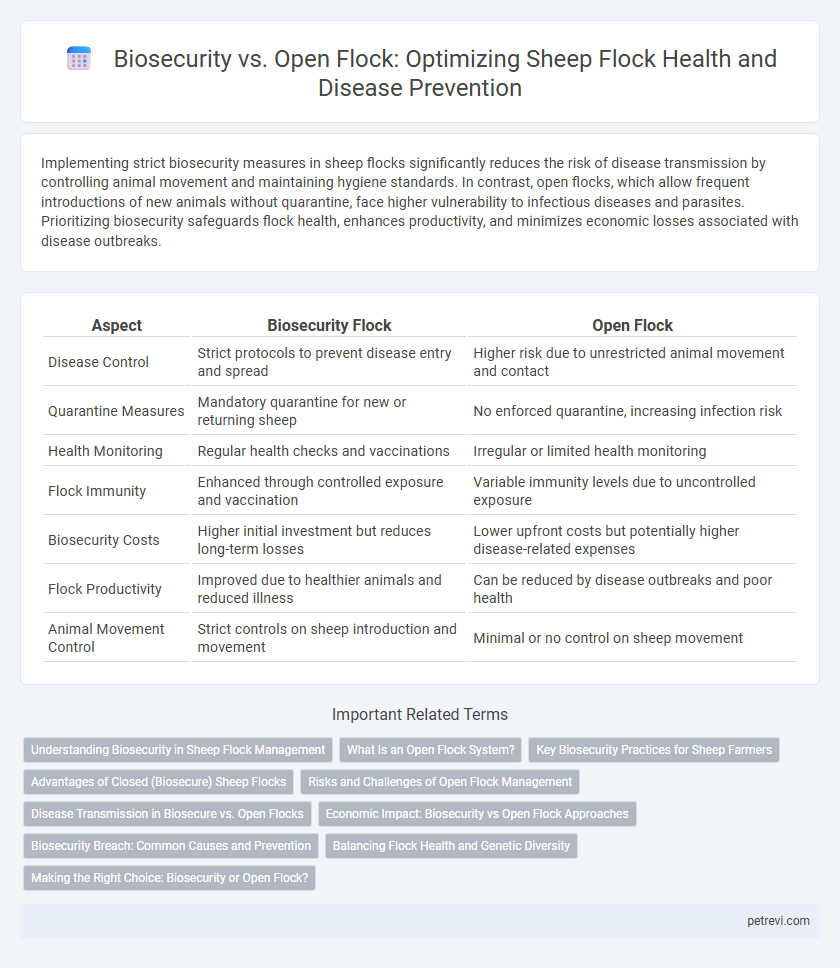Implementing strict biosecurity measures in sheep flocks significantly reduces the risk of disease transmission by controlling animal movement and maintaining hygiene standards. In contrast, open flocks, which allow frequent introductions of new animals without quarantine, face higher vulnerability to infectious diseases and parasites. Prioritizing biosecurity safeguards flock health, enhances productivity, and minimizes economic losses associated with disease outbreaks.
Table of Comparison
| Aspect | Biosecurity Flock | Open Flock |
|---|---|---|
| Disease Control | Strict protocols to prevent disease entry and spread | Higher risk due to unrestricted animal movement and contact |
| Quarantine Measures | Mandatory quarantine for new or returning sheep | No enforced quarantine, increasing infection risk |
| Health Monitoring | Regular health checks and vaccinations | Irregular or limited health monitoring |
| Flock Immunity | Enhanced through controlled exposure and vaccination | Variable immunity levels due to uncontrolled exposure |
| Biosecurity Costs | Higher initial investment but reduces long-term losses | Lower upfront costs but potentially higher disease-related expenses |
| Flock Productivity | Improved due to healthier animals and reduced illness | Can be reduced by disease outbreaks and poor health |
| Animal Movement Control | Strict controls on sheep introduction and movement | Minimal or no control on sheep movement |
Understanding Biosecurity in Sheep Flock Management
Effective sheep flock health depends heavily on rigorous biosecurity measures that prevent disease introduction and spread among animals. Integrating targeted protocols such as quarantine for new arrivals, regular health monitoring, and controlled access to pastures reduces risks compared to open flock management systems. Emphasizing biosecurity enhances flock immunity, minimizes economic losses, and supports sustainable sheep farming operations.
What Is an Open Flock System?
An open flock system allows sheep producers to introduce new animals regularly, enhancing genetic diversity but increasing exposure to diseases and biosecurity risks. Unlike closed flocks, open systems require rigorous quarantine and health testing protocols to mitigate the transmission of pathogens like footrot and ovine Johne's disease. Maintaining strict biosecurity measures in open flocks is essential to protect overall flock health and prevent outbreaks.
Key Biosecurity Practices for Sheep Farmers
Implementing key biosecurity practices such as quarantine for new sheep, regular health monitoring, and controlled access can significantly reduce disease risk in sheep flocks. Maintaining closed flocks minimizes pathogen introduction by limiting livestock movement and contact with external animals. Effective sanitation of facilities, proper disposal of waste, and vaccination protocols further enhance flock health and productivity.
Advantages of Closed (Biosecure) Sheep Flocks
Closed sheep flocks maintain strict biosecurity protocols that prevent the introduction of infectious diseases, reducing illness and mortality rates significantly compared to open flocks. By limiting contact with outside animals, closed systems minimize exposure to parasites, bacteria, and viruses, ensuring improved flock health and productivity. This approach also facilitates better control of breeding programs and genetic quality, enhancing long-term flock resilience and performance.
Risks and Challenges of Open Flock Management
Open flock management in sheep farming increases exposure to infectious diseases due to uncontrolled contact with wild or neighboring flocks, posing significant biosecurity risks. Pathogens such as foot-and-mouth disease, parasites, and respiratory infections spread more easily, complicating disease prevention and control efforts. Limited monitoring and inconsistent vaccination protocols further challenge maintaining flock health and productivity in open systems.
Disease Transmission in Biosecure vs. Open Flocks
Biosecurity in sheep flocks significantly reduces disease transmission by limiting contact with external animals and controlling farm access, effectively preventing pathogens like footrot and scrapie. Open flocks, where animals mix frequently with neighboring or wild sheep, experience higher risks of infectious diseases spreading rapidly through the population due to uncontrolled exposure. Implementing strict biosecurity protocols, including quarantine and sanitary measures, enhances flock health by minimizing outbreaks and maintaining herd immunity.
Economic Impact: Biosecurity vs Open Flock Approaches
Implementing stringent biosecurity measures in sheep flocks significantly reduces the incidence of infectious diseases, leading to lower veterinary costs and higher productivity compared to open flock systems. Open flock approaches expose sheep to greater risks of disease transmission, often resulting in increased mortality rates and economic losses due to decreased wool and meat quality. Investing in biosecurity enhances flock health and profitability by minimizing outbreaks and improving overall animal welfare.
Biosecurity Breach: Common Causes and Prevention
Biosecurity breaches in sheep flocks often result from unauthorized animal introductions, contaminated equipment, and inadequate quarantine protocols. Preventive measures include strict isolation of new or returning animals, regular disinfection of tools and facilities, and comprehensive staff training on biosecurity practices. Maintaining a closed flock with rigorous monitoring minimizes disease transmission and supports overall flock health.
Balancing Flock Health and Genetic Diversity
Maintaining flock health in sheep requires a strategic balance between stringent biosecurity measures and preserving genetic diversity through open flock management. Implementing biosecurity protocols reduces the introduction of infectious diseases but can limit genetic variation, potentially affecting long-term flock resilience. Incorporating controlled gene flow from external sources while monitoring health status supports sustainable flock improvement without compromising disease control.
Making the Right Choice: Biosecurity or Open Flock?
Selecting biosecurity measures for sheep flock health enhances disease prevention by limiting pathogen exposure through controlled access, quarantine, and sanitation protocols, essential for mitigating risks such as footrot and Ovine Johne's disease. Conversely, an open flock approach allows natural gene flow and environmental adaptation but increases vulnerability to infections like scrapie and internal parasites due to unrestricted animal movement. Balancing the benefits of biosecurity against the genetic diversity and resilience offered by open flocks is crucial for sustainable sheep health management.
Biosecurity vs Open Flock for Sheep Flock Health Infographic

 petrevi.com
petrevi.com